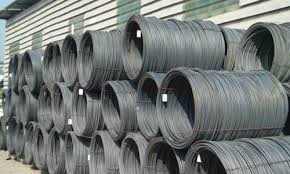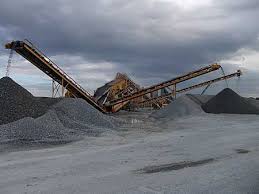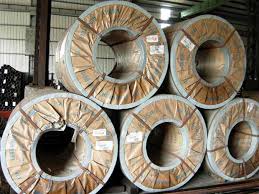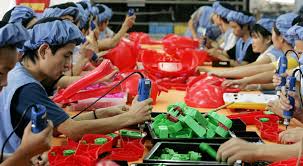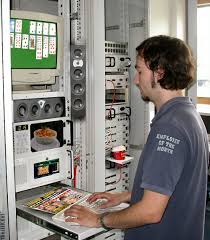The purpose of this post is to discuss some of the possible pitfalls that a lender could encounter when lending on inventory that is managed with a standard cost system. During this post we will discuss:
- The difference between management and financial accounting, as it applies to inventory and standard cost systems.
- The various components of inventory costs (materials, labor and overhead) and how they are impacted by manufacturing efficiencies (or more importantly inefficiencies).
- The calculation of price and manufacturing variances and how to calculate appropriate borrowing base ineligibles if they exist.
- The role of field exams and appraisals in mitigating the risks posed by inventory valued at standard costs.
Accounting Systems
Before we get into the specifics of inventory standard costs and price/manufacturing variances and what these items could mean to a lender’s collateral, we should understand the difference between management accounting and financial accounting.
- Management Accounting is the use of accounting information by an organization’s management team to effectively manage their organization.
- The information that is developed in management accounting is done so at management’s request and strictly for their use.
- Usually the information is confidential and not shared with the public
- Management accounting information is in no way regulated, there are no standards. Management tools and the information that they convey are only as good and reliable as the organizations systems allow.
- Financial Accounting is the use of accounting information to develop information (financial statements) used by outside investors to make investment decisions.
- The information that is developed is often done so either at the request of an outside entity (such as a lender if the organization is privately held) or is mandated by various governing bodies (Securities and Exchange Commission)
- The information developed by financial accounting is generally done so to share with the public or an outside interest.
- Financial Accounting information must follow standards both in the presentation and interpretation of the information (Generally Accepted Accounting Principles, or “GAAP”) and in the the gathering and analysis of the data (Generally Accepted Auditing Standards, or “GAAS”).
The above distinction is important because inventory costing systems that employ a standard cost are management accounting systems, they are not acceptable for financial accounting. Hopefully, the reasons for this will become clear as we work through the examples, but suffice it to say that financial accounting is based on actual costs incurred and revenues realized, whereas management accounting is based on assumptions and estimates developed over time. Another way to think of it is that the purpose of financial accounting is to measure what has already occurred in real dollars, whereas the purpose of management accounting is to give business managers the tools necessary optimize a Company’s profits by being able to forecast costs and revenues based on prior history as well as known and unknown variables.
When lending on inventory that is based on a standard costing system. Lenders (or at least the examiners performing the collateral exam) need to understand the source and method used to calculate the standard as well as how the Company handles variances from those established standards.
The video below shows the manufacturing process of an Audi Q7. As you watch the video, think about the costs involved in manufacturing a car. In particular think about the cost of materials, labor and overhead and how a company would go about developing a standard or average cost for each component and or finished product.
Below are discussions regarding the three components of a manufactured item’s costs; materials, overhead and labor.
Material Costs
Most manufacturers know exactly how much and what type of materials are needed in the production of an item. Often material amounts are easily identifiable for each item produced through “bills of material,” cost sheets, or recipes. Because the same amount and type of material is used for each item produced of a similar style, the material costs of each unit is often easily defined (number of units times the cost per unit). For example, if a company uses resin in its production process and the item being made requires 4 ounces, it is fairly easy to calculate the cost of the resin for each unit.
Developing standards for material costs is generally a relatively straight forward exercise. The company can easily determine the quantities purchased, and the amounts paid. Determining a standard can be as easy as dividing the total costs for a product by the quantities purchased. Assigning the cost of material to the standard unit cost of a finished good, merely involves multiplying the units of the material used in the production by the standard cost per unit.
Material costs incurred during the manufacturing process are generally 100% variable, the units of material used is directly related to the number of items produced. For example, in the video above, the cost of steel used during the production process is directly related to the number of Q7’s that Audi produces.
Labor Costs
The cost of labor is a little more tricky, as the labor costs have both fixed and variable components. Typically a company can ask employees to work overtime, add shifts or increase the number of lines involved in the manufacture of a product when more volume is needed. However, if the maximum capacity of an 8 hour shift is 1,000 units and the Company is required to have at least one full shift, the cost of labor may be the same for producing 800 units as it is for producing 1000 units.
As an example lets assume the following:
- A company has a labor contract that calls for employees to be paid for a minimum of 8 hours regardless of the number of hours they are actually “on the line” or producing goods. If the employee is called into work, he or she will be paid for a minimum 8 hours and more than 8 hours if overtime is needed.
- Now assume that a manufacturing facility can produce 100,000 units per year per 8 hour shift when operating at full capacity, This is done by producing 2,000 units per week with the plant shut down for two weeks for mandatory vacation time.
- Lets also assume that the cost of employing one shift for a full year is $400,000.00
The cost of labor on a per unit basis will be higher when volumes cause the Company to operate at less than full capacity, as the employees are still paid for a full 8 hour shift. If our hypothetical manufacturing Company above produced 80,000 units in a year, the cost of labor for each unit would be $5.00 ($400,000/80,000), likewise if the volume were for the full capacity amount of 100,000 the cost per unit would be $4.00.
The above illustrates that there could be a wide range of values assigned to a unit cost depending on when the standards are set and the assumptions made by management.
Overhead Costs
Overhead costs are all of the other costs associated with the direct production of goods that is not labor or material. these may include the cost of machinery, rent and utility costs of the manufacturing facility, maintenance costs, tooling, and any other costs associated with making a product.

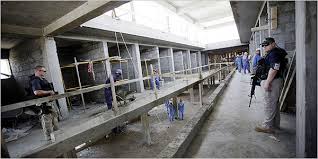


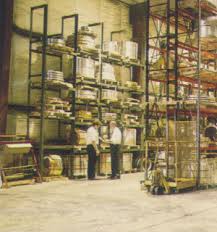
An example of an overhead cost directly associated with the production of goods is a robot. The impact of volume on the unit cost of an item is even more pronounced for overhead cost items than it is for labor. If a robot paints 1,000 car bodies or 100,000 car bodies the cost of the robot is the same to the Company, however, the allocated cost of the robot on a per unit (car body) basis is going to be very different.
For example, lets assume that an air conditioning manufacturer purchases a robot for $200,000. The expected life of the robot is 10 years, and the company utilizes straight line depreciation. The “cost” of the robot will be $20,000 per year. The Company decides to include the cost of depreciation in its development of standard costs; after all, the robot is directly involved with the manufacturing process. Unfortunately the company experiences wide variances in demand for its product. During years that are relatively warm, or have extended heat waves, sales increase. During cooler years they decrease. Sales can vary from 10,000 units to 20,000 units. Assuming that the company manufactures only what it sells, the cost of the robot on a per unit basis could be $2.00 or $1.00 depending on volumes sold. If the standard costs are established during a high volume year, the cost per unit will be lower as there is a larger number of items to allocate the fixed costs to.
Because of the effect that volume fluctuations can have on standard costs, many lenders prefer to exclude labor and overhead costs from eligible collateral and lend on material costs only. However, by understanding the calculation and allocation of purchase price and manufacturing variances, it may be feasible to lend on all components of inventory costs. Special care should be taken however to ensure that the Company’s policies and procedures are completely understood. The next section will address variances and how to treat them in the borrowing base.
Variances to the Standard Costs
As you may imagine, standard costing systems are rarely accurate. Unless the current conditions are exactly the same as the conditions used to calculate the standard costs, there are going to be variances between the actual and standard costs. These variances are divided into two categories “Purchase Price Variances” or PPV’s and “Manufacturing Variances.”
Variances are often referred to as either negative or positive. From the Company’s perspective a variance is Positive, when it causes the Company to realize more profit than what it expected to based on the standard cost. For example if the standard cost for a unit is $3.00 and the actual or real cost is $2.50, the company has a positive variance as it made $0.50 more per unit than it expected to. For a lender the impact of a standard that is too high is the exact opposite. Positive variances, are indications that the the inventory may be overstated.
Purchase Price Variances
To illustrate how variances work lets assume that a Company has a standard price for a widget at $1.50 per item. Now lets assume that the actual price per widget is 1.25. If the Company purchased 10,000 widgets the entry would be:
|
DR |
CR |
|
| Inventory at Standard |
15,000 |
|
| Cash |
12,500 |
|
| Purchase Price Variance |
2,500 |
|
| To record purchase of 1000 widgets |
Assuming that the Company sells all of its product and the widgets are 100% consumed, the PPV account would be “closed” to the cost of goods sold. This would entail, debiting the PPV for $2,500 and crediting the cost of sales for $2,500. This would naturally cause the cost of sales to be decreased and gross profits to be increased by the $2,500. If the Company consumed only a portion of the 10,000 widgets, then it would be proper to allocate the PPV between to cost of sales and a contra asset account so that inventory is properly stated. For example if 8,000 units are used and sold, the ending inventory at standard would be 2,000 X 1.5 or $3,000; however, the actual cost of the widgets was $1.25, so the true “lower of cost or market” value is 2,000 X 1.25 or 2,500. In this scenario the cost of sales should be reduced by $2,000 and the inventory balance should be shown as $2,500 ($3,000 at standard, less the PPV of $500).
Many Companies do not bother allocating the variances and simply “flush” the variance through the cost of sales. If this is the case, and if the standard costs are higher than actual, the inventory value at standard will be inflated. It will be necessary to analyze the cost of sales account to determine how much the cost of sales were reduced for the variance and how much of that variance to reserve for. There are several methods for calculating the reserve. We would stress that it is important to ensure that any calculation contain measurements from like periods. For example if the variance is based on three months activity, it should be allocated based on three months of turnover. For example if the PPV is flushed through the COGS, it will be necessary to review the COS account and determine the PPV amount realized, Once that is determined the turnover needs to be determined. An inventory that turns over 4 times per year, turns over once per quarter. If there are only six months of statements available the reserve should be calculated by annualizing the PPV (PPV’s realized over the last six months) divided by the number of times the inventory turns over. Lets assume the numbers above represents 6 months of activity, the PPV realized thus far would be $3,000 (we are assuming that the entire PPV goes to COGS and that the Company does not “capitalize” the PPV). Now we had 10,000 widgets and we sold 8,000. Our inventory is currently at 2,000 units @ a 1.50 standard or $3,000. We know that the actual value is $2,500 (2,000 x 1.25) , the PPV reserve that gets allocated back to the balance sheet needs to be $500. ($3,000 stated inventory value, less the $500 to get the inventory to actual/market cost). inventory Turn over for the 6 month period is 8,000 units used divided by 10,000 units available, this results in a turnover of 0.8. The total variance was $2,500. 0.8 of the Variance is $2,000, this is the amount that should be realized; therefore, an adjustment should be made to reallocate $500 of the PPV back to inventory (debit COGS and credit inventory for $500). This will cause the inventory to be properly presented as $2,500, or the $3,000 “book” value less the $500 PPV that is capitalized to the remaining inventory.
Manufacturing Variances
Manufacturing Variances are slightly more complicated and nuanced as the variance could be based on worker efficiency , M&E efficiencies, process efficiencies, labor rates and amortization rates and other assumed direct charges being different from actual rates and expenses; however, from a lenders perspective the treatment would be the same as a purchase price variance. This would entail:
- Determining the actual costs and comparing those costs to the standard costs
- Determining the Amount and time period of the variance
- Determining the turnover for the period.
- Multiply the variance by the turnover.
What about Appraisals?
Many lenders rely heavily on appraisals to determine if inventory can be lent on and what the advance rate should be. Appraisals are exceptional tools and the discussion above is not meant to discount their value, but rather to highlight the need for a thorough understanding of a Company’s business and how changing factors can and do transform a once meaningful appraisal into one that may not be worth the paper it is printed on. If anything, this post should point to the need for good appraisals performed frequently. Many lenders perform appraisals when a deal is first underwritten, and then rely on that appraisal for the next several years. If inventory is being reported via an inventory listing that is valued on a management calculated standard cost, then it is imperative that changes to those standards be understood and that the impact of those changes is properly mitigated. Field exams can and should identify standard costs, changes to cost components, changes to the inventory composition and key metrics such as turnover and margins. Appraisals should be updated frequently to mitigate those changes.
Usually the end result of an appraisal is the determination of the “orderly liquidation” value. This is loosely defined as the amount of money a lender could expect to realize should the inventory need to be liquidated. Because inventory balances are constantly changing, and borrowers want credit for increased collateral value, while lenders want to protect themselves from declining collateral values, the OLV is often applied as a percentage of the perpetual inventory. This allows the inventory used to determine the borrowing availability to be adjusted for changes in inventory values.
For example, if at the time of an appraisal to total inventory value was $1,000M and the appraised “OLV” or orderly liquidation value was $787M, the OLV% would be 78.7%. The OLV percentage can then be used to estimate the inventory’s orderly liquidation value in the next reporting cycle.
A lender could face a huge risk if factors used in determining the OLV% change materially from the original calculation. For example, if the cost of producing a product were to increase materially and those costs can not be passed on so that the OLV% does not increase proportionately, the OLV% used in determining the borrowing availability can quickly become inaccurate and/or obsolete.
Based on the discussion above, it is easy to see how changes to the standard costs can have a huge impact on the OLV. Its easy to see that when lending on inventory even when appraisals are used, it is important to track and monitor inventory levels, components of inventory and the inventory variances to standard.
Field Exams
Field examiners can not be expected to determine if a company’s standard costs are appropriate; however, there are several steps that should be included in the scope of any deal where inventory is part of the collateral base, and/or borrowing formula. the steps below can be especially helpful when inventory is valued with a standard cost system:
- Trend Analysis – A trend analysis of inventory by category can be used to identify changes to various components of inventory. Often these components will have different OLV’s per the appraisal. Changes in the composition of the inventory may warrant a change in the OLV to reflect the current weighting of the various components.
- Item Analysis – Similar to a trend analysis, an item analysis can be used to identify material variances in certain items or item classifications. For example a funiture manufacturer may produce tables and chairs, with tables having one OLV percentage, chairs another, and complete sets a third OLV percentage. By analyzing and comparing the various items that make up the total inventory, the examiner should be able to determine if the current inventory composition is in line with the composition of the inventory at the time of the appraisal.
- Turnover Analysis – The turnover analysis, both on a total basis and at the SKU level can be used to determine if slow moving reserves are appropriate, and if those reserves are reflected in the current OLV percentage.
- Cost Test – The cost test can be used to verify the purchase price variance accrued by the borrower and ultimately the amount that should be included in any inventory reporting. It can also be used to track and compare the current cost components of materials, labor and overhead to the relative levels of these components at the time of the appraisal.
- Gross Profit Test – The gross profit test can be used to identify changes in standard costs that are not passed on to customers. For example if margins based on standard are shrinking it could be an indication that management has raised the standards. Without a corresponding increase in market value, this would warrant a reduction in the OLV% used (or the advance rate applied to the OLV%), as the resulting increase in inventory value is not true increase in the intrinsic value of that inventory.
Conclusion
By incorporating proper collateral monitoring and due diligence, a lender can mitigate much of the risk associated with inventory valuations based on standards. Field exams should be performed frequently and the scope of the exam should be customized so that changes to the standards used are at least identified and to the extent possible quantified. The field exam should also identify price and manufacturing variances and the need for any corresponding ineligibles. In addition, appraisals should be updated frequently so that OLV%’s used properly reflect the market values relative to the inventory standard cost values.
That’s it for now. Please feel free to leave a comment or question. If you would rather contact me directly you can email us at [email protected]
For samples of reports prepared by ECG please visit http://www.ecgenterprises.com/reports

